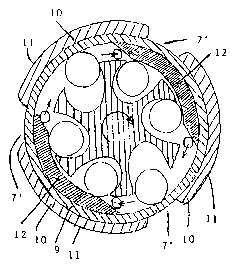Une partie des informations de ce site Web a été fournie par des sources externes. Le gouvernement du Canada n'assume aucune responsabilité concernant la précision, l'actualité ou la fiabilité des informations fournies par les sources externes. Les utilisateurs qui désirent employer cette information devraient consulter directement la source des informations. Le contenu fourni par les sources externes n'est pas assujetti aux exigences sur les langues officielles, la protection des renseignements personnels et l'accessibilité.
L'apparition de différences dans le texte et l'image des Revendications et de l'Abrégé dépend du moment auquel le document est publié. Les textes des Revendications et de l'Abrégé sont affichés :
| (12) Demande de brevet: | (11) CA 2396532 |
|---|---|
| (54) Titre français: | MOTEUR DE FORAGE A PALETTES ET A ROULEAUX A TREPAN OU RACCORD COUDE LONG |
| (54) Titre anglais: | LONG GAUGE ROLLER VANE DRILLING MOTOR |
| Statut: | Réputée abandonnée et au-delà du délai pour le rétablissement - en attente de la réponse à l’avis de communication rejetée |
| (51) Classification internationale des brevets (CIB): |
|
|---|---|
| (72) Inventeurs : |
|
| (73) Titulaires : |
|
| (71) Demandeurs : |
|
| (74) Agent: | SMART & BIGGAR LP |
| (74) Co-agent: | |
| (45) Délivré: | |
| (86) Date de dépôt PCT: | 2000-01-06 |
| (87) Mise à la disponibilité du public: | 2001-07-12 |
| Licence disponible: | S.O. |
| Cédé au domaine public: | S.O. |
| (25) Langue des documents déposés: | Anglais |
| Traité de coopération en matière de brevets (PCT): | Oui |
|---|---|
| (86) Numéro de la demande PCT: | PCT/NL2000/000010 |
| (87) Numéro de publication internationale PCT: | NL2000000010 |
| (85) Entrée nationale: | 2002-07-05 |
| (30) Données de priorité de la demande: | S.O. |
|---|
L'invention concerne un moteur de forage à palettes et à rouleaux à une enveloppe pour le forage fond de trou horizontal et dévié. L'enveloppe (9) du moteur selon l'invention comporte sur sa circonférence un ou plusieurs éléments courbes (10) de façon à créer une nouvelle surface externe circulaire plus grande (11) ayant un diamètre à peu près égal à celui du trépan en dessous, un ou plusieurs évidements longitudinaux (7') étant ménagés pour la remontée du fluide de forage à la surface. Les éléments courbes (10) peuvent commencer en dessous de l'extrémité inférieure du moteur ou à son extrémité inférieure et peuvent ou non s'étendre jusqu'à son extrémité supérieure.
A single-jacket roller vane drilling motor for downhole deviated and
horizontal drilling has its jacket (9) provided at its circumgerence with one
or more curved members (10) in such a way that a new, larger circular outside
surface (11) is created with a diameter approximately equal to that of the
drill bit below, and whereby one or more longitudinal recesses (7') are
created for passage of the drilling fluid back to the surface. The curved
members (10) may start below the lower end of the motor or at its lower end
and may or may not extend to its upper end.
Note : Les revendications sont présentées dans la langue officielle dans laquelle elles ont été soumises.
Note : Les descriptions sont présentées dans la langue officielle dans laquelle elles ont été soumises.

2024-08-01 : Dans le cadre de la transition vers les Brevets de nouvelle génération (BNG), la base de données sur les brevets canadiens (BDBC) contient désormais un Historique d'événement plus détaillé, qui reproduit le Journal des événements de notre nouvelle solution interne.
Veuillez noter que les événements débutant par « Inactive : » se réfèrent à des événements qui ne sont plus utilisés dans notre nouvelle solution interne.
Pour une meilleure compréhension de l'état de la demande ou brevet qui figure sur cette page, la rubrique Mise en garde , et les descriptions de Brevet , Historique d'événement , Taxes périodiques et Historique des paiements devraient être consultées.
| Description | Date |
|---|---|
| Inactive : CIB de MCD | 2006-03-12 |
| Demande non rétablie avant l'échéance | 2004-01-06 |
| Le délai pour l'annulation est expiré | 2004-01-06 |
| Réputée abandonnée - omission de répondre à un avis sur les taxes pour le maintien en état | 2003-01-06 |
| Inactive : Page couverture publiée | 2002-12-02 |
| Lettre envoyée | 2002-11-28 |
| Inactive : Notice - Entrée phase nat. - Pas de RE | 2002-11-28 |
| Demande reçue - PCT | 2002-09-13 |
| Exigences pour l'entrée dans la phase nationale - jugée conforme | 2002-07-05 |
| Demande publiée (accessible au public) | 2001-07-12 |
| Date d'abandonnement | Raison | Date de rétablissement |
|---|---|---|
| 2003-01-06 |
Le dernier paiement a été reçu le 2002-07-05
Avis : Si le paiement en totalité n'a pas été reçu au plus tard à la date indiquée, une taxe supplémentaire peut être imposée, soit une des taxes suivantes :
Les taxes sur les brevets sont ajustées au 1er janvier de chaque année. Les montants ci-dessus sont les montants actuels s'ils sont reçus au plus tard le 31 décembre de l'année en cours.
Veuillez vous référer à la page web des
taxes sur les brevets
de l'OPIC pour voir tous les montants actuels des taxes.
| Type de taxes | Anniversaire | Échéance | Date payée |
|---|---|---|---|
| Taxe nationale de base - générale | 2002-07-05 | ||
| TM (demande, 2e anniv.) - générale | 02 | 2002-01-07 | 2002-07-05 |
| Enregistrement d'un document | 2002-07-05 |
Les titulaires actuels et antérieures au dossier sont affichés en ordre alphabétique.
| Titulaires actuels au dossier |
|---|
| ULTIDRILL B.V. |
| Titulaires antérieures au dossier |
|---|
| ARNOLD WILLEM JOSEPHUS GRUPPING |